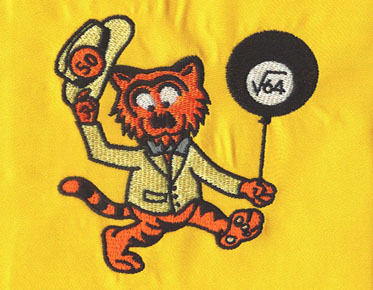Here's Everything You Need to Know About Embroidery Digitization...
Embroidery digitization is quite a hot thing these days and
many people are ditching their traditional designs in favor of something modern
and fashionable. If you want to be updated with the times, then it's time for
you to learn more about embroidery digitization!
Embroidery digitization is the process
of converting a design or image into a stitch file that can be read by an
embroidery machine. This process is usually done with the help of special
software that allows the user to create a splice file from scratch or using an
existing image or design. Before you begin, you should know a few things about
embroidery digitization, and we've listed some of the most important Pointers
below. Whether you're just starting out in the world of embroidery or looking
to get more out of your design, these tips will help you make the most of your
digital work.
Embroidery digitization software
usually includes a variety of tools and features that allow users to create
high-quality stitch files. These files can then be transferred to an embroidery
machine for stitching. Common features of embroidery digitization software
include the ability to convert images into stitches, add text, change colors,
and more.
The history of embroidery
digitization
Embroidery digitization is the process
of converting a design or image into a stitch file that can be read by an
embroidery machine. The process enables greater flexibility and precision in
the final product.
Embroidery digitization dates back to
the early days of computer-aided design (CAD). In the late 1970s, commercial
embroidery machines began to appear on the market. These machines are equipped
with basic punch card input devices that can only produce simple designs.
With the development of CAD
technology, embroidery digital software is also developing. Early software was
very limited and often difficult to use. However, as more people began to use
computers for design work, the software gradually became more user-friendly and
feature-rich.
Today, there are many different types
of embroidery digitization software available, each with its own unique
features and functions. Whether you want to create simple designs or detailed
artwork, there is a software program that can help you achieve your goals.
How to digitize embroidery design?
There is a lot of interest in learning
how to digitize embroidery designs. If you are one of them, then this article
is for you. Here, we will provide a step-by-step guide on how to digitize
embroidery designs using software Adobe Illustrator.
First, you need to open Adobe
Illustrator and create a new file. You will then need to scan the image to be
used for the embroidery design. After scanning the image, you need to open it
in Adobe Illustrator.
Next, you need to trace the outline of
the image using the Pen Tool. After tracing the outline, you need to fill in
the color. You can use the paint Bucket tool or the Gradient Tool to fill in
the color.
Once you have filled in the colors,
you need to use the pencil tool to add some details to the design. After you
have added all the required details, you need to save the file as an.ai file
format.
That's it! Now you know how to
digitize your embroidery design using Adobe Illustrator.
The benefits of embroidery
digitization
There are many benefits to embroidery
going digital. Simply put, digitization is the process of converting a design
or image into a stitch file that can be read by an embroidery machine. This
process allows for greater precision and detail in the final product.
Digitization of embroidery also
offers many other advantages, including:
1. Increase efficiency: Digitizing
your design can help you work faster and more efficiently. Using stitch files,
you can program the embroidery machine to automatically sew designs. This can
save you a lot of time, especially when dealing with large or complex designs.
2. Greater accuracy: As mentioned
above, digitizing your design helps ensure greater accuracy in the final
product. With an embroidery machine, you can set specific stitching parameters,
such as stitch length and width. This allows you to create finer details in
your design than if you were sewing by hand.
3. More Complex designs: Digitizing
embroidery also opens up the possibility of creating designs that are more
complex than sewing by hand alone. Using an embroidery machine, you can combine
multiple colors and stitches to create detailed and intricate patterns.
4. Enhance durability: Embroidered
items made from digital documents are also often more durable than those sewn
by hand. Stitching is usually stronger and less likely to unravel over time.
5. Increase versatility: Digitizing
your designs also enables you to easily replicate them in a variety of
different materials. Using an embroidery machine, you can sew designs onto
fabric, paper, leather and even wood.
6. Cost savings: Finally, digitizing
your design can help you save money in the long run. Once you've invested in
the software and equipment needed to digitally design, you can use them again
and again. This can help you avoid the costs associated with buying new
patterns by hiring embroidery digitization services.
Different types of embroidery machines
Embroidery machines come in all
shapes, sizes and colors. They can be used for a variety of different projects,
from simple to complex. There are three main types of embroidery machines:
1. Manual Embroidery machines: These
machines are manually operated and use needle and thread. They are often used
for small projects, such as monograms or acronyms.
2. Computerized embroidery machines:
These machines are operated by computers and designed using dedicated software.
They can be used for projects ranging from simple to complex.
3. Embroidery machines with built-in
scanners: These machines have built-in scanners that allow you to scan images
and then embroider them into your project.
Embroidery digitization is a process
that can be used to create beautiful, complex designs on fabric. If you are
interested in learning more about this process, there are a few things you
should know. First, the process can be time-consuming, so it's important to be
patient. Second, you need to use embroidery machines and software, which can be
expensive. In the end, practice makes perfect - the more you stab, the better
your results will be.



